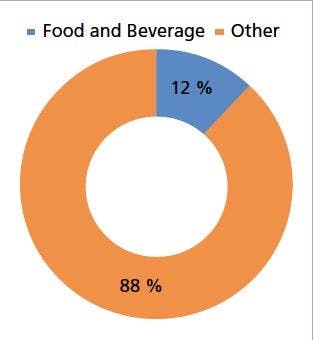Gaining Sensitivity in Environmental GC–MS
LCGC North America
Improve results by optimizing the injection, column, and detection.
Environmental samples often come in large volumes or large volumes are created during sample preparation. Injection of volumes that are often hundreds of times greater than those normally found in gas chromatography (GC) can be problematic; however, it is also advantageous because the minimum detectable limits will decrease. Conventional analyses would use techniques such as preconcentration to reduce these large sample volumes, although this approach runs the risk of losing volatile components and causing analyte decomposition, and it can be time consuming. Programmed thermal vaporizing (PTV) inlets can be used to inject large-volume samples without the need for preconcentration. The sample is injected into a cool liner using either a continuous controlled flow or in multiple aliquots, a high carrier gas flow passes through the liner and out of the split vent, which evaporates the sample solvent, and after all of the sample has been introduced into the liner it is quickly heated to transfer the analytes on to the column. PTV offers an enhancement in sensitivity of 1–2 orders of magnitude versus splitless injection. For example, concentration ranges of 2.5–500 ng/mL are achieved using PTV versus 100–2500 ng/mL using splitless injection. This improved sensitivity meets trace-level detection requirements, and furthermore, this method of injection improves the peak shape of early eluted compounds because of the removal of solvent. PTV inlets do require some optimization, with the sample flow rate, liner, gas flows, and temperatures being important parameters.
The column can play an important role in improving sensitivity. Fast GC columns are shorter (normally 10 m) with a smaller diameter (0.1 mm, although 0.15 and 0.18 mm are more practical diameters that will give you the same results without the need for any changes to the system) and a thinner film (0.1 µm). Shorter columns with small diameters allow the use of increased carrier gas linear velocities and column oven heating rates; analysis time is reduced without reducing the peak resolution, and sensitivity is increased because of the narrow peaks produced in addition to the increase in signal-to-noise ratio (S/N). Furthermore, columns with thinner films bleed less, which reduces background noise, increases S/N, and ultimately improves sensitivity. One potential drawback of fast GC and GC–mass spectrometry (MS) methods is the need for detectors that can rapidly scan the narrow peaks that are generated to collect sufficient data for reliable quantitation. Fast GC–MS and GC–MS/MS analyses result in peaks that are very sharp and are eluted very quickly (full width at half maximum is below 1 s).
Mass spectrometers must be optimized to gain the best sensitivity for an application. In relation to data collection, parameters such as mass range (must cover all analyte ions), scan speed (high scan speeds are required to maintain relative intensities across a narrow peak), and sampling frequency (number of scans per second) should be considered. The type of GC–MS experiment being carried out will have a significant impact on sensitivity. For example, greater sensitivity can be achieved through the increased specificity of a GC–MS/MS experiment in comparison to GC–MS measurements. GC–MS/MS offers additional advantages, such as, additional spectral separation dimension for complex samples, acquisition of structural information (MS/MS or MSn), spectral deconvolution of isobaric interferences (high-resolution MS), lower detection limits when tuned to specific ions, and analysis and characterization of very complex samples-tens to thousands of components. Multiple reaction monitoring (MRM) eliminates matrix noise and allows only the selected product ion through the second quadrupole; although sensitivity is actually less, the noise is reduced, which increases S/N. MRM detection limits are usually 5–10 times lower than those achieved by selected ion monitoring. MRM experiments can be optimized to provide optimum sensitivity. An optimized MRM transition should include a precursor ion, product ion, and optimized collision energy. Identify unique (high mass) and abundant precursor ions and optimize instrument parameters to gain maximum sensitivity. The product ion or ions (fragments) should give the highest signal abundance-this result may be achieved using a scan function on Q3.
Attention should be paid to the uniqueness of the fragment ions; a larger mass difference between parent and precursor ions tends to be more specific. Dwell time affects the abundance of each ion or transition, the use of smart MRM technology provided by vendors allows for high-speed scanning control and simultaneous scan and MRM analysis, which produces high-quality library searchable fragmentation and accurate low-level quantitative data in a single analysis. The software automatically adjusts the analytical dwell time for each transition, only acquiring data during peak elution, to fully optimize sensitivity.

Miniaturized GC–MS Method for BVOC Analysis of Spanish Trees
April 16th 2025University of Valladolid scientists used a miniaturized method for analyzing biogenic volatile organic compounds (BVOCs) emitted by tree species, using headspace solid-phase microextraction coupled with gas chromatography and quadrupole time-of-flight mass spectrometry (HS-SPME-GC–QTOF-MS) has been developed.
Fundamentals of Benchtop GC–MS Data Analysis and Terminology
April 5th 2025In this installment, we will review the fundamental terminology and data analysis principles in benchtop GC–MS. We will compare the three modes of analysis—full scan, extracted ion chromatograms, and selected ion monitoring—and see how each is used for quantitative and quantitative analysis.
Characterizing Plant Polysaccharides Using Size-Exclusion Chromatography
April 4th 2025With green chemistry becoming more standardized, Leena Pitkänen of Aalto University analyzed how useful size-exclusion chromatography (SEC) and asymmetric flow field-flow fractionation (AF4) could be in characterizing plant polysaccharides.













